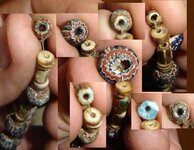monsterrack
Silver Member
- Apr 15, 2013
- 4,419
- 5,819
- Detector(s) used
- Garrett, and Whites
- Primary Interest:
- All Treasure Hunting
I see folks asking about trade beads and thought why not show them some. This is a few of different types that I have been blessed with.View attachment 882421View attachment 882423View attachment 882429
Upvote
0








